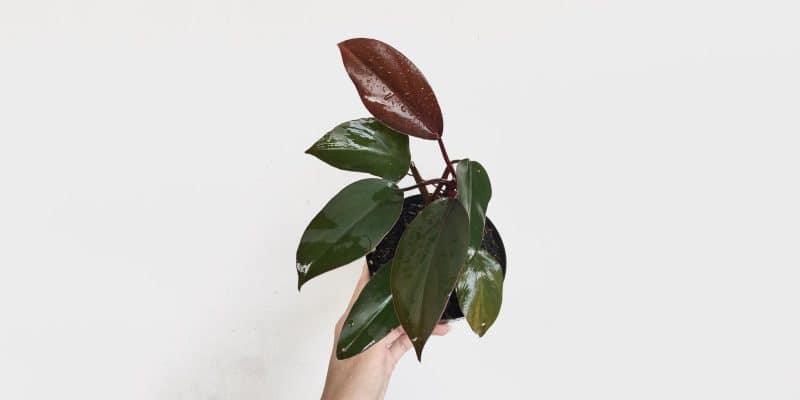There’s a mysterious new character reigning over our plant-loving hearts, and it goes by the name of Philodendron Dark Lord.
From the Araceae plant family, Philodendron Dark Lord is a low-maintenance tropical plant known for its deep dark green leaves with almost a dark purple hue, and darker red stems.
Every plant lover needs a regal touch in their collection, and the Philodendron Dark Lord is here to claim its throne.
We’ll delve into everything you need to know about Philodendron Dark Lord care, from its deliciously dark appearance to the royal treatment it deserves.
Table of Contents
Philodendron Dark Lord Plant Care Guide
History, Habitat, and Characteristics
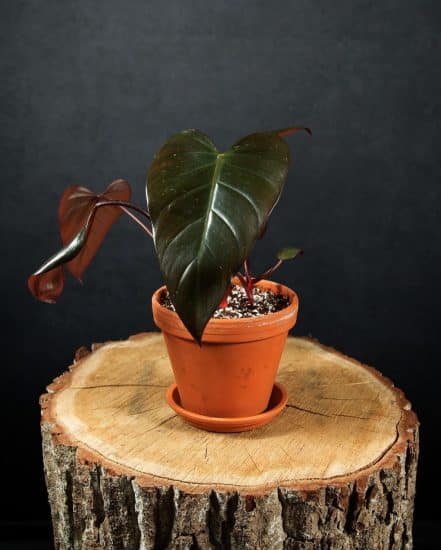
Philodendron Dark Lord (Philodendron erubescens ‘Dark Lord’) is a relatively new climber that’s a hybrid of Philodendron ‘Imperal Red.’ Hailing from the tropical regions of Central America (although it also grows in other places too, like the Philippines and Northern Africa).
It thrives in steamy rainforests and is (as you can probably tell) is known for its dark coloration.
What really sets this plant apart from its leafy brethren is its almost black dark green leaves with a reddish hue. Even the roots, stems, petioles, and leaves are dressed to impress with a touch of red.
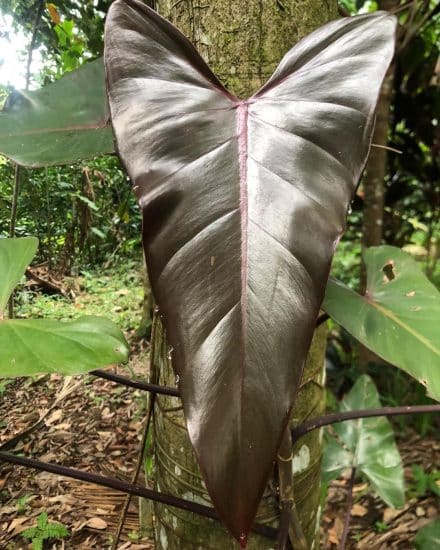
And as the Dark Lord matures, its leaves grow large. How large? 20 to 22 inches long! The plant itself can reach up to five feet tall inside, especially with the help of moss poles or a trellis.
A curious aspect of the Philodendron Dark Lord is its metamorphosis. Youngsters display lance-shaped leaves without the fiery redness found in mature plants, making it hard to believe they’ll grow up to be the same plant.
Once they come of age, new leaves make a grand entrance in a dazzling blood-red color with large petioles and aerial roots perfect for climbing.
Since the Dark Lord loves to reach for the skies, providing a moss pole or support stick is essential. It’ll need some careful guidance as it grows, so make sure to tie it firmly but gently to its support system.
Despite its dramatic demeanor, Philodendron Dark Lord is a friendly plant that won’t mind the little inaccuracies in its media portrayal. Social media images might show off shockingly red hues on its mature leaves, but the reality can be a bit more understated.
Light
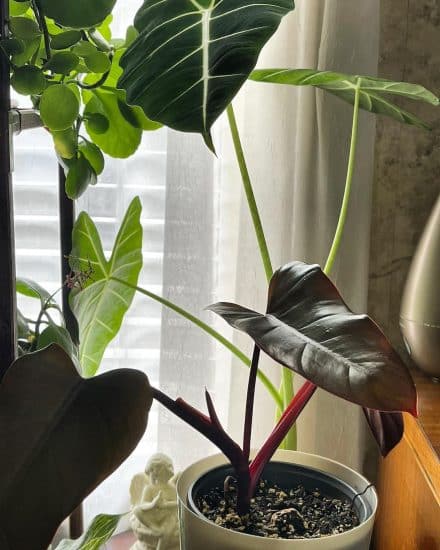
To grow Philodendron Dark Lord, make sure it gets a whole lot of bright, indirect light. Interestingly, the brighter the light, the larger its leaves will grow. Doesn’t it know what’s good for itself?!
To achieve optimal results, keep your plant a few feet away from a west or south-facing window or close to an east-facing one.
The Dark Lord has a preference for less light to maintain its deep, dark foliage — excessive light exposure may cause the leaves to lose their richness and become brighter.
Keep in mind that lower light levels can also result in the plant stretching and becoming etiolated.
Our lighting tips:
- Look out for signs of insufficient light, like pale or elongated leaves, and adjust the plant’s location as needed.
- Avoid giving too much direct sunlight, which can lead to washed-out leaves that lose their dark hue.
- Aim for ideal light conditions by placing the plant near an east-facing or west-facing window but avoiding direct, scorching sun.
- Should natural light prove insufficient, consider employing a grow light to supplement and maintain the Dark Lord’s . . . dark foliage.
Water
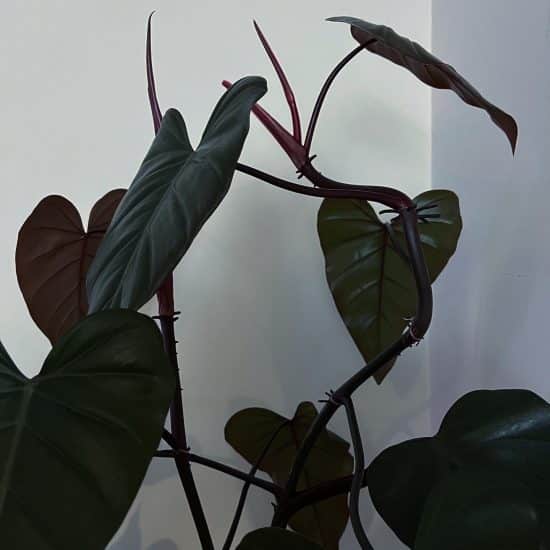
Water your Dark Lord Philodendron when the soil is about halfway or slightly more dry, especially if it’s placed in higher light conditions. Overwatering and underwatering can both negatively impact your plant’s health. (Womp womp).
If the Philodendron Dark Lord’s not receiving enough water, you’ll see curling or wilting leaves, as well as older leaves near the base turning yellow.
To address this issue, increase your watering frequency and remove any yellowing leaves to prevent spider mite infestations.
On the other hand, too much water can lead to discolored leaves and consistently moist soil. You may also notice mushy stems, brown and black spots on the leaves, and black or dead roots, all signs of Erwinia blight disease.
In this case, cut back on your watering frequency and allow the soil to dry out to help the plant recover.
Our tips:
- Consider using a moisture meter to accurately determine when your philodendron plant needs water, helping you prevent overwatering or underwatering.
- Don’t forget to remove any yellowing or damaged leaves to prevent pests like spider mites from damaging your plant further.
Temperature and Humidity
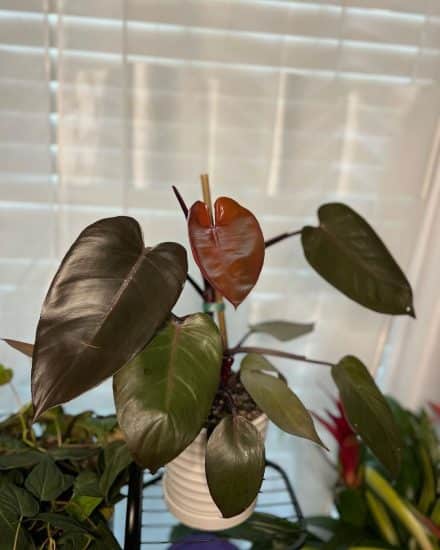
Like most tropical plants, Philodendron Dark Lord thrives in warm temperatures and high humidity.
Temperature: The Philodendron Dark Lord loves warm environments. Aim for a temperature range between 65-80°F (18-27°C) during the day, allowing for a slight decrease at night. Be cautious of temperatures below 55°F (13°C), as this may cause harm to your plant.
Keep your Dark Lord away from drafty windows and doors, particularly during colder months (avoiding temperature-related issues is crucial).
Signs of an incorrect temperature include wilting or yellowing leaves, indicating exposure to temperatures that are either too low or too high. Adjust the temperature accordingly to help your plant flourish.
Humidity: Higher humidity levels are vital for a thriving Philodendron Dark Lord, with an optimal level around 60%. If humidity drops below 40%, the plant may display signs of distress, like brown leaf tips or drooping leaves.
On the other hand,, excessive humidity and poor airflow can result in mold and mildew problems.
Ensure your Philodendron Dark Lord is in a space with good air circulation and consistent humidity levels, like a conservatory (if you’re fancy) or among other humidity-loving plants. Good airflow is essential to prevent overcrowding and dampness in the room.
To raise humidity:
- Place your plant on a pebble tray filled with water to enhance local humidity.
- Use a humidifier nearby to maintain consistent humidity levels.
- Group your Philodendron Dark Lord with other humidity-loving plants, creating a microclimate that retains moisture.
- Lightly mist the leaves, but be cautious not to overdo it — you need good ventilation to avoid mold and mildew issues.
Soil and Planting
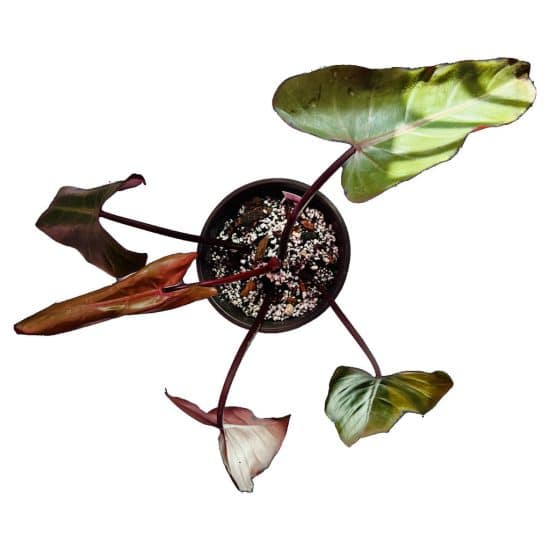
It’s crucial to use an airy, well-draining soil mix for the Philodendron Dark Lord.
You can create the perfect blend by combining regular potting soil with coco coir, orchid bark, and perlite, or even opt for a succulent mix that promotes good drainage.
This rich organic mix will allow the roots to breathe and prevent excess water from causing damage to the extensive root system (nobody wants a soggy plant!).
Fertilizing
When it comes to nourishing your Philodendron Dark Lord, consistency is vital. Feed your plant with a balanced liquid fertilizer rich in nutrients every month during the growing season, using fish emulsion or Gold Leaf liquid fertilizer as excellent nutrient sources.
Be careful, though, since overfertilizing can cause yellowing leaves, browning tips, and stunted growth (sometimes less is more). To fix an overfertilized plant, flush the soil with water and reduce the frequency or amount of fertilizer applied.
To repot Philodendron Dark Lord, whether you’re a fan of terracotta or ceramic, pick a container that complements your home decor. (Good drainage and air circulation to your plant’s roots is also a must).
Remember, drainage holes are your plant’s best friend, keeping those roots healthy and preventing waterlogging. You should see your plant standing upright, never drooping downward. Avoid root bound issues by repotting when necessary.
Propagation
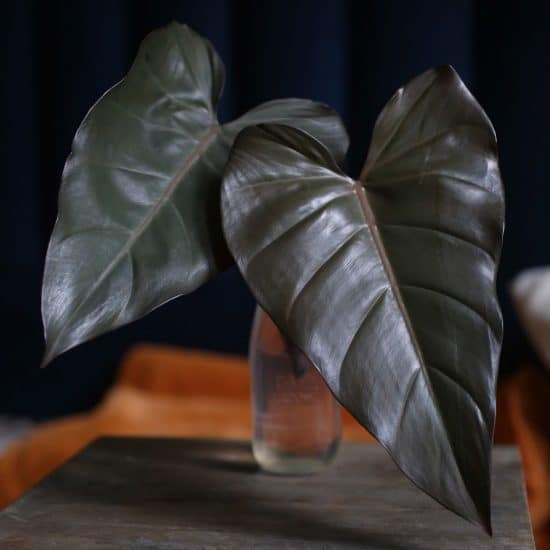
Want to propagate Philodendron Dark Lord? Who wouldn’t?! You can do it by using top stem cuttings or air layering.
Propagating Philodendron Dark Lord through stem cutting:
- Find a healthy stem on your Dark Lord Philodendron with at least two leaves and a visible node. Ensure the stem looks strong and shows no signs of disease or pests, like spider mites.
- Snip the stem with sterile gardening shears or a sharp and clean pair of scissors, cutting just below a leaf node.
- Remove any lower leaves from the stem cutting, leaving only one or two leaves at the top.
- Pop the cutting into a glass of water or an airy soil mix with coco coir. Keep the cutting in a warm, bright spot with indirect sunlight. Remember, propagation can take time, especially if the cutting gets low light.
- Keep an eye on the cutting for root growth. Once the roots are one to two inches long, you can transfer the cutting to a pot with well-draining potting mix.
Propagating Philodendron Dark Lord through air layering:
- Pick a healthy stem on your Dark Lord plant with at least one leaf node and visible aerial roots.
- Create a small incision just below the node, taking care not to cut all the way through the stem. This will encourage roots to form at this spot.
- Wrap some moist sphagnum moss around the incision.
- Cover the moss with plastic wrap or a plastic bag to keep the humidity high. Secure it in place using string or twist ties.
- Check on the moss regularly and keep it moist by misting with water when needed. Once the roots are visibly growing in the moss, carefully cut the stem below the new roots and pot the new Dark Lord Philodendron plant in a container with well-draining potting mix.
Our propagation tips:
- Patience is key! Philodendron Dark Lord can take around four months to root and show new growth, so don’t worry if you don’t see immediate results.
- Make sure the cutting or air layering site gets bright, indirect light to encourage healthy root development.
- When potting the new plant, opt for a well-draining potting mix.
Common Issues
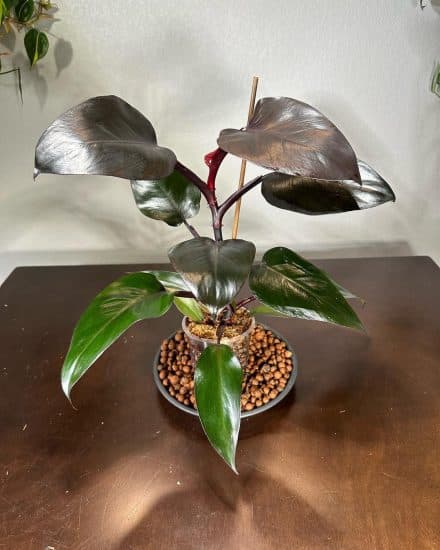
Even the healthiest Dark Lords can face some challenges, like slow-growing leaves and dormancy in winter.
Slow Leaf Growth
One common issue with Philodendron Dark Lord plants is slow leaf growth or the appearance of smaller leaves. This problem could be due to insufficient light or inadequate nutrients.
Place your plant in a bright spot that receives indirect sunlight, ensuring it gets enough light to promote healthy growth. Keep an eye on the soil moisture, adjusting your watering routine when necessary, and making sure the soil mix remains moist but not soggy.
This will encourage larger, more vibrant leaves and prevent stunted growth.
Dormancy in Winter
During colder months, the Philodendron Dark Lord might enter a dormant phase, causing slower or halted growth. It’s crucial to maintain a consistent indoor temperature and provide your plant with ample indirect light during this time.
You may need to slightly reduce watering frequency, as the plant’s water requirements diminish during dormancy (but do keep monitoring the soil moisture). Rest assured, your plant is likely to resume more vigorous growth once the warmer months return.
Embrace this opportunity to manage your plant’s size and maintain its appearance, creating a visually appealing display even during its dormant phase.
Pests and Diseases
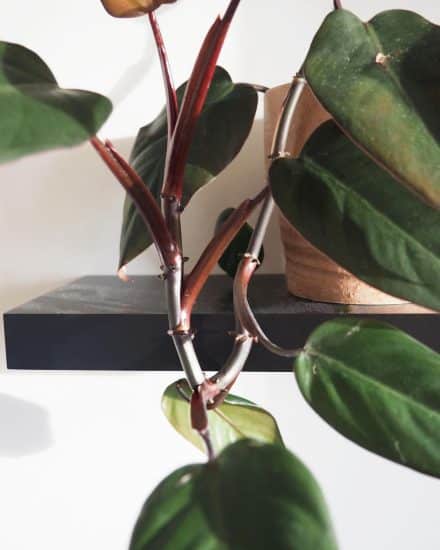
Philodendron Dark Lords, also known as Dark Knight Philodendron, are generally tough tropical plants, but every now and then, they might face a few challenges with pests and diseases like Erwinia blight disease.
Pests
Even though Dark Lord Philodendron plants aren’t particularly susceptible to pests, they can sometimes be bothered by mealybugs, spider mites, whiteflies, or thrips.
Keep an eye out for tiny, cotton-like bugs on your plant’s leaves and huge bright red stems, or small black insects that hop or fly when disturbed (a sign you might have a pest problem).
Got pests? No problem! Start by wiping off affected areas with a damp cloth.
For more stubborn infestations, mix up a neem oil solution (just follow the directions on the label) and give your Philodendron Dark Lord a good spray, being sure to cover both sides of the dark green leaves.
Neem oil works as a natural preventative, but you can also try systemic houseplant pesticides like Provanto if needed.
Erwinia Blight Disease
This particular issue is unfortunately something many indoor philodendron plants, including your Dark Lord Philodendron, can run into. It happens when the plant’s roots sit in waterlogged moist soil for too long, causing dead or black roots.
Keep an eye out for pale shade yellowing or wilting leaves, brown patches, a funky smell, or blackened, squishy roots (aka root rot).
If you find your plant suffering from this disease, follow these simple steps to get it back on track:
- Gently remove your plant from its pot and snip away the affected roots with clean, sterilized scissors (you don’t want to spread any infection).
- Swap out the old soil for a fresh, well-draining potting mix, preferably one with ingredients like perlite, pumice, or LECA to improve aeration and drainage. This will help stop Erwinia blight disease from reoccuring.
- Repot your mature Dark Lord Philodendron in its new home, and water with care until it shows signs of recovery. Remember to check the moisture levels and only water when the top few inches of moist soil are dry to the touch.
Conclusion
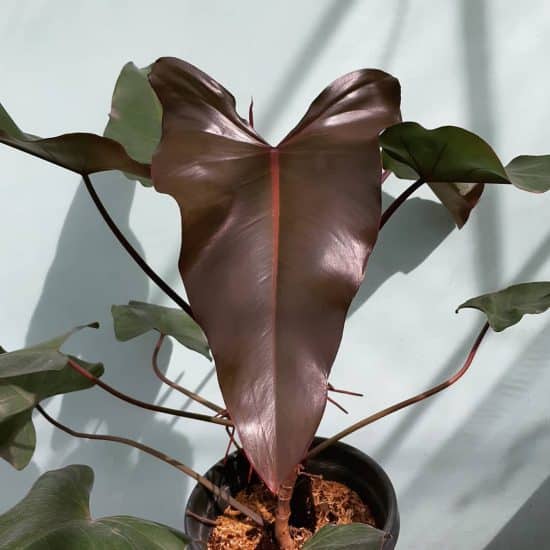
That’s it for our Philodendron Dark Lord care guide! Whether you call it Dark Knight Philodendron or Dark Lord, you now have all the information you need to care for this houseplant and help it reign supreme in your home. Or office. Or wherever, really.
Philodendron Dark Lord care summary:
- Place your plant in bright, indirect light to encourage healthy growth and maintain its stunning dark foliage (avoid direct sunlight!).
- Water when the top few inches of soil are dry, taking care to avoid overwatering or underwatering.
- Maintain a temperature range between 65-80°F (18-27°C) and a humidity level around 60% for optimal growth conditions.
- Use an airy, well-draining soil mix and a pot with drainage holes to prevent root rot and promote healthy growth.
- Fertilize regularly in the growing months but cautiously, avoiding overfertilization that could harm your plant.
- Propagate via stem cuttings or air layering to share the beauty of the Philodendron Dark Lord with friends or expand your own collection.
We hope this guide helps you confidently care for your Philodendron Dark Lord. If you have any questions or want to share your Dark Lord’s progress, feel free to reach out to us. We love seeing your photos!
Take care, and happy planting!
FAQ
Is Philodendron Dark Lord rare?
Yes. As of this writing, Philodendron Dark Lord is a relatively new member of the plant fam, which means it’s a rare plant that’s both in demand and hard to find. It’s a cultivar of the ‘Imperial Red’ Philodendron erubescens.
What is another name for the Philodendron Dark Lord?
Philodendron Dark Lord is sometimes called Dark Knight Philodendron. Both courtly names for the same plant, no?
How do you make a Philodendron Dark Lord darker?
Give it less light! A healthy Dark Lord needs bright indirect light. In fact, too much light can make its leaves too bright. The Bright Lord? Doesn’t have the same ring.
Is Dark Lord Philodendron toxic?
Yes. Dark Lord Philodendron is considered a toxic plant because of the calcium oxalate crystals its leaves produce, so be sure to keep it away from curious children and pets.

